
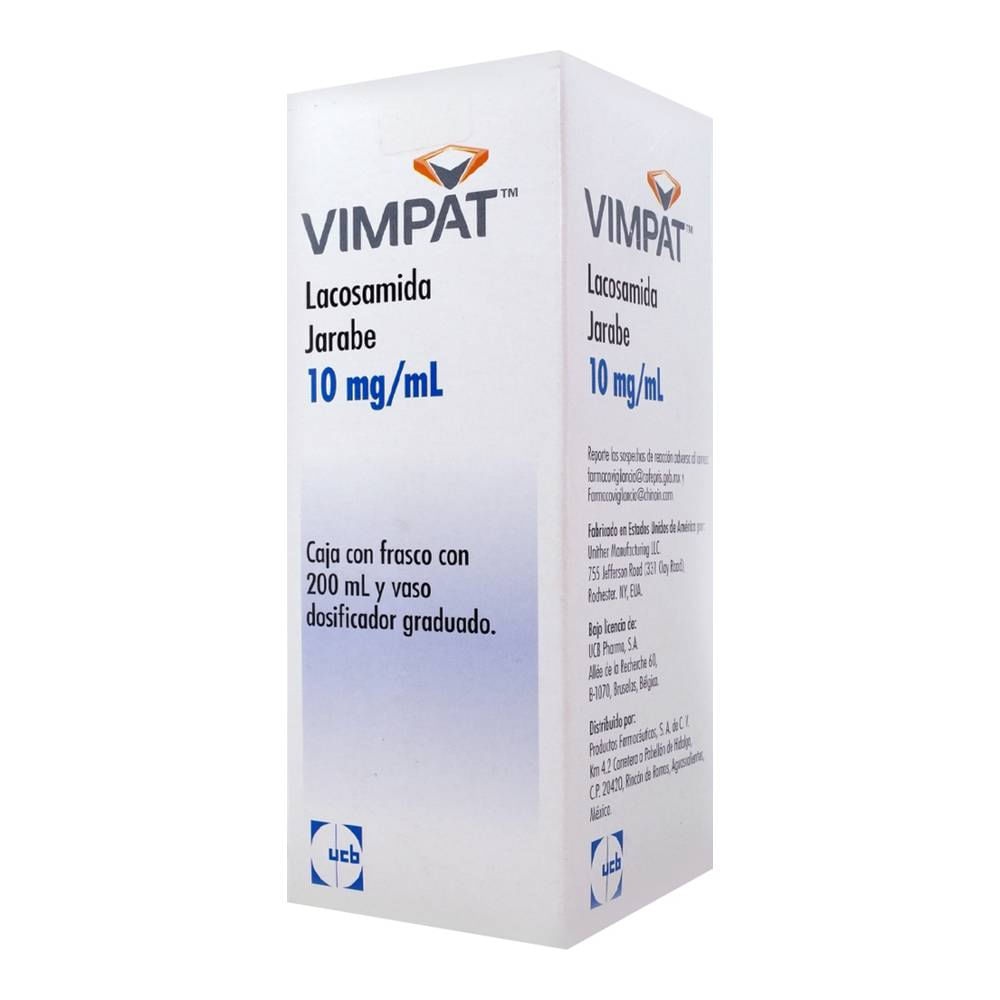
ВИМПАТ 10 мг/мл СИРОП

Спросите врача о рецепте на ВИМПАТ 10 мг/мл СИРОП

Инструкция по применению ВИМПАТ 10 мг/мл СИРОП
Введение
Инструкция: информация для пациента
Вимпат 10 мг/мл сироп
лакосамид
Прочитайте внимательно всю инструкцию перед началом приема этого препарата, поскольку она содержит важную информацию для вас.
- Сохраните эту инструкцию, поскольку вам может потребоваться прочитать ее снова.
- Если у вас есть какие-либо вопросы, проконсультируйтесь с вашим врачом или фармацевтом.
- Этот препарат назначен только вам и не должен быть передан другим людям, даже если у них такие же симптомы, как у вас, поскольку он может нанести им вред.
- Если вы испытываете побочные эффекты, проконсультируйтесь с вашим врачом или фармацевтом, даже если это побочные эффекты, которые не указаны в этой инструкции. См. раздел 4.
Содержание инструкции
- Что такое Вимпат и для чего он используется
- Что вам нужно знать перед началом приема Вимпата
- Как принимать Вимпат
- Возможные побочные эффекты
- Хранение Вимпата
- Содержание упаковки и дополнительная информация
1. Что такое Вимпат и для чего он используется
Что такое Вимпат
Вимпат содержит лакосамид, который принадлежит к группе препаратов, называемых "противоэпилептическими препаратами". Эти препараты используются для лечения эпилепсии.
- Вам назначен этот препарат для снижения количества приступов, которые вы испытываете.
Для чего используется Вимпат
- Вимпат используется:
- в качестве монотерапии и в комбинации с другими противоэпилептическими препаратами у взрослых, подростков и детей от 2 лет для лечения определенного типа эпилепсии, характеризующегося возникновением приступов с парциальным началом с или без вторичной генерализации. При этом типе эпилепсии приступы поражают только одну сторону мозга. Однако они могут затем распространиться на более крупные области в обеих сторонах мозга;
- в комбинации с другими противоэпилептическими препаратами у взрослых, подростков и детей от 4 лет для лечения первичных генерализованных тónico-клонических приступов (больших приступов с потерей сознания) у пациентов с идиопатической генерализованной эпилепсией (тип эпилепсии, который, как считается, имеет генетическую природу).
2. Что вам нужно знать перед началом приема Вимпата
Не принимайте Вимпат
- если вы аллергичны к лакосамиду или любому из других компонентов этого препарата (перечисленных в разделе 6). Если вы не уверены, что вы аллергичны, проконсультируйтесь с вашим врачом.
- если у вас есть проблема с сердечным ритмом, называемая блокадой AV II или III степени.
Не принимайте Вимпат, если любой из вышеуказанных пунктов применим к вашему случаю. Если вы не уверены, проконсультируйтесь с вашим врачом или фармацевтом перед приемом этого препарата.
Предостережения и меры предосторожности
Проконсультируйтесь с вашим врачом перед началом приема Вимпата, если:
- у вас есть мысли о самоубийстве или причинении вреда себе. Небольшое количество людей, принимающих противоэпилептические препараты, такие как лакосамид, имели мысли о самоубийстве или причинении вреда себе. Если в любой момент у вас появляются такие мысли, немедленно свяжитесь с вашим врачом.
- у вас есть проблема с сердцем, которая влияет на сердечный ритм, и ваш пульс часто бывает особенно медленным, быстрым или нерегулярным (например, блокада AV, фибрилляция предсердий или трепетание предсердий)
- у вас есть тяжелое сердечное заболевание, такое как сердечная недостаточность, или вы перенесли инфаркт миокарда.
- Вы часто головокружитесь или падаете. Вимпат может вызывать головокружение, что может увеличить риск случайных травм или падений. Это означает, что вам нужно быть осторожным, пока вы не привыкнете к эффектам этого препарата.
Если любой из вышеуказанных пунктов применим к вашему случаю (или вы не уверены), проконсультируйтесь с вашим врачом или фармацевтом перед приемом Вимпата.
Если вы принимаете Вимпат, проконсультируйтесь с вашим врачом, если вы испытываете новый тип приступов или ухудшение существующих приступов.
Если вы принимаете Вимпат и испытываете симптомы аномального сердечного ритма (такие как медленный, быстрый или нерегулярный сердечный ритм, сердцебиение, одышка, головокружение, обморок), немедленно проконсультируйтесь с вашим врачом (см. раздел 4).
Дети
Вимпат не рекомендуется детям младше 2 лет с эпилепсией, характеризующейся возникновением приступов с парциальным началом, и не рекомендуется для детей младше 4 лет с первичными генерализованными тónico-клоническими приступами. Это связано с тем, что еще не известно, является ли он эффективным и безопасным для детей этой возрастной группы.
Другие препараты и Вимпат
Сообщите вашему врачу или фармацевту, если вы принимаете, недавно принимали или можете принять любой другой препарат.
В частности, сообщите вашему врачу или фармацевту, если вы принимаете любой из следующих препаратов, которые влияют на сердце, поскольку Вимпат также может влиять на сердце:
- препараты для лечения сердечных проблем;
- препараты, которые могут увеличить "интервал PR" в тесте на сердце (ЭКГ или электрокардиограмма), такие как препараты для эпилепсии или боли, называемые карбамазепином, ламотриджином или прегабалином;
- препараты, используемые для лечения определенных типов аритмии или сердечной недостаточности.
Если любой из вышеуказанных пунктов применим к вашему случаю (или вы не уверены), проконсультируйтесь с вашим врачом или фармацевтом перед приемом Вимпата.
Также сообщите вашему врачу или фармацевту, если вы принимаете любой из следующих препаратов, поскольку они также могут увеличить или уменьшить эффект Вимпата в вашем организме:
- препараты для лечения грибковых инфекций, такие как флуконазол, итраконазол или кетоконазол;
- препараты для лечения ВИЧ, такие как ритонавир;
- препараты для лечения бактериальных инфекций, такие как кларитромицин или рифампицин;
- растительный препарат, используемый для лечения легкой тревоги и депрессии, называемый зверобоем.
Если любой из вышеуказанных пунктов применим к вашему случаю (или вы не уверены), проконсультируйтесь с вашим врачом или фармацевтом перед приемом Вимпата.
Прием Вимпата с алкоголем
В качестве меры безопасности не принимайте Вимпат с алкоголем.
Беременность и лактация
Женщины детородного возраста должны обсудить использование противозачаточных средств с врачом.
Если вы беременны или кормите грудью, считаете, что можете быть беременной или планируете стать беременной, проконсультируйтесь с вашим врачом или фармацевтом перед использованием этого препарата.
Не рекомендуется принимать Вимпат, если вы беременны, поскольку не известно, как Вимпат влияет на беременность и плод.
Не рекомендуется кормить грудью ребенка во время приема Вимпата, поскольку Вимпат проникает в грудное молоко.
Немедленно проконсультируйтесь с вашим врачом, если вы беременны или планируете стать беременной. Он поможет вам решить, следует ли принимать Вимпат или нет.
Не прерывайте лечение без предварительной консультации с вашим врачом, поскольку это может увеличить количество приступов (приступов). Ухудшение вашего заболевания также может нанести вред плоду.
Вождение и использование машин
Не следует водить, ездить на велосипеде или использовать любые инструменты или машины, пока вы не узнаете, как этот препарат влияет на вас. Причина в том, что Вимпат может вызывать головокружение или размытое зрение.
Вимпат содержит сорбитол, натрий, метилпара-гидроксибензоат натрия, аспартам, пропиленгликоль и калий
- Сорбитол (тип сахара). Этот препарат содержит 187 мг сорбитола в каждом мл. Сорбитол является источником фруктозы. Если ваш врач указал, что вы (или ваш ребенок) страдаете непереносимостью определенных сахаров или если вам диагностирована врожденная непереносимость фруктозы (ВНФ), редкое генетическое заболевание, при котором пациент не может расщеплять фруктозу, проконсультируйтесь с вашим врачом перед приемом или получением (или перед тем, как ваш ребенок примет или получит) этого препарата. Сорбитол может вызывать желудочно-кишечные расстройства и легкий слабительный эффект.
- Натрий (соль). Этот препарат содержит 1,42 мг натрия (основной компонент столовой соли) в каждом мл. Это эквивалентно 0,07% от максимальной рекомендуемой суточной нормы потребления натрия для взрослого.
- Метилпара-гидроксибензоат натрия (Е219) может вызывать аллергические реакции (возможно, задержанные).
- Аспартам (Е951). Этот препарат содержит 0,032 мг аспартама в каждом мл. Аспартам является источником фенилаланина, который может быть вредным, если у вас есть фенилкетонурия (ФКН), редкое генетическое заболевание, при котором фенилаланин накапливается, поскольку организм не может правильно его вывести.
- Пропиленгликоль (Е1520). Этот препарат содержит 2,14 мг пропиленгликоля в каждом мл.
- Калий. Этот препарат содержит калий, менее 1 ммоль (39 мг) на 60 мл; это означает, что он практически "не содержит калия".
3. Как принимать Вимпат
Следуйте точно инструкциям по применению этого препарата, указанным вашим врачом или фармацевтом. В случае сомнений проконсультируйтесь с вашим врачом или фармацевтом.
Применение Вимпата
- Принимайте Вимпат дважды в день, с интервалом примерно 12 часов.
- Пытайтесь принимать его примерно в одно и то же время каждый день.
- Вы можете принимать Вимпат с пищей или без нее.
Обычно вы начнете с низкой дозы каждый день, и ваш врач постепенно увеличит дозу в течение нескольких недель. Когда вы достигнете дозы, которая хорошо подходит вам, называемой "поддерживающей дозой", вы будете принимать одну и ту же количество каждый день. Вимпат используется как долгосрочное лечение.
Вам необходимо продолжать принимать Вимпат, пока ваш врач не скажет вам прекратить.
Какое количество принимать
Ниже перечислены рекомендуемые нормальные дозы Вимпата для разных возрастных групп и весов.
Ваш врач может назначить вам другую дозу, если у вас есть проблемы с почками или печенью.
Используйте шприц для перорального применения объемом 10 мл (черные деления) или мерный стакан объемом 30 мл, поставляемый в наружной упаковке, в соответствии с необходимой дозой. См. инструкции по применению ниже.
Подростки и дети, весящие 50 кг или более, и взрослые
Когда вы принимаете Вимпат в одиночку:
Обычная начальная доза составляет 50 мг (5 мл), дважды в день.
Ваш врач может назначить вам начальную дозу 100 мг (10 мл) Вимпата, дважды в день.
Ваш врач может увеличить дозу, которую вы принимаете дважды в день, на 50 мг (5 мл) каждую неделю, пока вы не достигнете поддерживающей дозы между 100 мг (10 мл) и 300 мг (30 мл), дважды в день.
Когда вы принимаете Вимпат с другими противоэпилептическими препаратами
Обычная начальная доза составляет 50 мг (5 мл), дважды в день.
Ваш врач может увеличить дозу, которую вы принимаете дважды в день, на 50 мг (5 мл) каждую неделю, пока вы не достигнете поддерживающей дозы между 100 мг (10 мл) и 200 мг (20 мл), дважды в день.
Если вы весите 50 кг или более, ваш врач может решить начать лечение Вимпатом с единовременной "загрузочной" дозы 200 мг (20 мл). Затем вы начнете принимать поддерживающую дозу через 12 часов.
Дети и подростки, весящие менее 50 кг
- При лечении парциальных приступов: обратите внимание, что Вимпат не рекомендуется для детей младше 2 лет.
- При лечении генерализованных тónico-клонических приступов: обратите внимание, что Вимпат не рекомендуется для детей младше 4 лет.
Когда вы принимаете Вимпат в одиночку.
- Ваш врач решит, какая доза Вимпата вам подходит, исходя из вашего веса.
- Обычная начальная доза составляет 1 мг (0,1 мл) на килограмм (кг) веса, дважды в день.
- Ваш врач может увеличить дозу, которую вы принимаете дважды в день, на 1 мг (0,1 мл) на килограмм (кг) веса каждую неделю, пока вы не достигнете поддерживающей дозы.
- Ниже приведены таблицы дозирования с максимально рекомендуемой дозой.
- Эти дозы являются лишь информативными. Ваш врач рассчитает правильную дозу для вас.
Принимать дважды в деньдетям от 2 лет, весом от 10 до менее 40 кг
Вес | Неделя 1 Начальная доза: 0,1 мл/кг | Неделя 2 0,2 мл/кг | Неделя 3 0,3 мл/кг | Неделя 4 0,4 мл/кг | Неделя 5 0,5 мл/кг | Неделя 6 Максимальная рекомендуемая доза: 0,6 мл/кг |
Использование шприца объемом 10 мл (черные деления) для объема от 1 мл до 20 мл
| ||||||
10 кг | 1 мл | 2 мл | 3 мл | 4 мл | 5 мл | 6 мл |
15 кг | 1,5 мл | 3 мл | 4,5 мл | 6 мл | 7,5 мл | 9 мл |
20 кг | 2 мл | 4 мл | 6 мл | 8 мл | 10 мл | 12 мл |
25 кг | 2,5 мл | 5 мл | 7,5 мл | 10 мл | 12,5 мл | 15 мл |
30 кг | 3 мл | 6 мл | 9 мл | 12 мл | 15 мл | 18 мл |
35 кг | 3,5 мл | 7 мл | 10,5 мл | 14 мл | 17,5 мл | 21 мл* |
Принимать дважды в день, для подростков и детей, весом от 40 кг до менее 50 кг
Вес | Неделя 1 Начальная доза: 0,1 мл/кг | Неделя 2 0,2 мл/кг | Неделя 3 0,3 мл/кг | Неделя 4 0,4 мл/кг | Неделя 5 Максимальная рекомендуемая доза: 0,5 мл/кг |
Использование шприца объемом 10 мл (черные деления) для объема от 1 мл до 20 мл
| |||||
40 кг | 4 мл | 8 мл | 12 мл | 16 мл | 20 мл |
45 кг | 4,5 мл | 9 мл | 13,5 мл | 18 мл | 22,5 мл* |
Когда вы принимаете Вимпат с другими противоэпилептическими препаратами
- Ваш врач решит, какая доза Вимпата вам подходит, исходя из вашего веса.
- Обычная начальная доза составляет 1 мг (0,1 мл) на килограмм (кг) веса, дважды в день.
- Ваш врач может увеличить дозу, которую вы принимаете дважды в день, на 1 мг (0,1 мл) на килограмм (кг) веса каждую неделю, пока вы не достигнете поддерживающей дозы.
- Ниже приведены таблицы дозирования с максимально рекомендуемой дозой.
- Эти дозы являются лишь информативными. Ваш врач рассчитает правильную дозу для вас.
Принимать дважды в деньдля детей от 2 лет, весом от 10 кг до менее 20 кг
Неделя | Неделя 1 Начальная доза: 0,1 мл/кг | Неделя 2 0,2 мл/кг | Неделя 3 0,3 мл/кг | Неделя 4 0,4 мл/кг | Неделя 5 0,5 мл/кг | Неделя 6 Максимальная рекомендуемая доза: 0,6 мл/кг |
Использование шприца объемом 10 мл (черные деления) для объема от 1 мл до 20 мл | ||||||
10 кг | 1 мл | 2 мл | 3 мл | 4 мл | 5 мл | 6 мл |
12 кг | 1,3 мл | 2,4 мл | 3,6 мл | 4,8 мл | 6 мл | 7,2 мл |
14 кг | 1,4 мл | 2,8 мл | 4,2 мл | 5,6 мл | 7 мл | 8,4 мл |
15 кг | 1,5 мл | 3 мл | 4,5 мл | 6 мл | 7,5 мл | 9 мл |
16 кг | 1,6 мл | 3,2 мл | 4,8 мл | 6,4 мл | 8 мл | 9,6 мл |
18 кг | 1,8 мл | 3,6 мл | 5,4 мл | 7,2 мл | 9 мл | 10,8 мл |
Принимать дважды в день, для подростков и детей, весом от 20 кг до менее 30 кг
Вес | Неделя 1 Начальная доза: 0,1 мл/кг | Неделя 2 0,2 мл/кг | Неделя 3 0,3 мл/кг | Неделя 4 0,4 мл/кг | Неделя 5 Максимальная рекомендуемая доза: 0,5 мл/кг |
Использование шприца объемом 10 мл (черные деления) для объема от 1 мл до 20 мл | |||||
20 кг | 2 мл | 4 мл | 6 мл | 8 мл | 10 мл |
22 кг | 2,2 мл | 4,4 мл | 6,6 мл | 8,8 мл | 11 мл |
24 кг | 2,4 мл | 4,8 мл | 7,2 мл | 9,6 мл | 12 мл |
25 кг | 2,5 мл | 5 мл | 7,5 мл | 10 мл | 12,5 мл |
26 кг | 2,6 мл | 5,2 мл | 7,8 мл | 10,4 мл | 13 мл |
28 кг | 2,8 мл | 5,6 мл | 8,4 мл | 11,2 мл | 14 мл |
Принимать дважды в день, для подростков и детей, весом от 30 кг до менее 50 кг
Вес | Неделя 1 Начальная доза: 0,1 мл/кг | Неделя 2 0,2 мл/кг | Неделя 3 0,3 мл/кг | Неделя 4 Максимальная рекомендуемая доза: 0,4 мл/кг |
Использование шприца объемом 10 мл (черные деления) для объема от 1 мл до 20 мл | ||||
30 кг | 3 мл | 6 мл | 9 мл | 12 мл |
35 кг | 3,5 мл | 7 мл | 10,5 мл | 14 мл |
40 кг | 4 мл | 8 мл | 12 мл | 16 мл |
45 кг | 4,5 мл | 9 мл | 13,5 мл | 18 мл |
Инструкции по применению
Важно использовать правильное устройство для измерения дозы. Ваш врач или фармацевт укажут, какое устройство использовать в зависимости от назначенной вам дозы.
Шприц для перорального применения объемом 10 мл | Мерный стакан объемом 30 мл |
Шприц для перорального применения объемом 10 мл имеет черные деления с шагом 0,25 мл. Если необходимая доза находится между 1 мл и 10 мл, вы должны использовать шприц для перорального применения объемом 10 мл и адаптер, поставляемый в этом упаковке. Если необходимая доза находится между 10 мл и 20 мл, вы должны использовать шприц объемом 10 мл дважды. | Мерный стакан объемом 30 мл имеет черные деления с шагом 5 мл. Если необходимая доза превышает 20 мл, вы должны использовать мерный стакан объемом 30 мл, включенный в это упаковку. |
Инструкции по применению: мерный стакан
- Встряхните хорошо флакон перед использованием.
- Наполните мерный стакан до деления, соответствующего миллилитрам (мл), назначенным вашим врачом.
- Проглотите дозу сиропа.
- Затем выпейте немного воды.
Инструкции по применению: шприц для перорального применения
Ваш врач покажет вам, как использовать шприц для перорального применения, прежде чем вы его используете впервые. Если у вас есть вопросы, проконсультируйтесь с вашим врачом или фармацевтом.
Встряхните хорошо флакон перед использованием.
Откройте флакон, повернув крышку против часовой стрелки (рисунок 1).
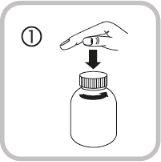
Следуйте следующим шагам при первом приеме Вимпата:
- Удалите адаптер из шприца для перорального применения (рисунок 2).
- Поместите адаптер на верхнюю часть флакона (рисунок 3). Убедитесь, что он хорошо закреплен. Не нужно удалять адаптер после использования.
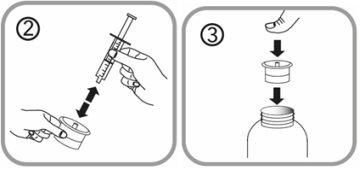
Следуйте следующим шагам каждый раз, когда вы принимаете Вимпат:
- Поместите шприц для перорального применения в отверстие адаптера (рисунок 4).
- Поместите флакон вниз (рисунок 5).
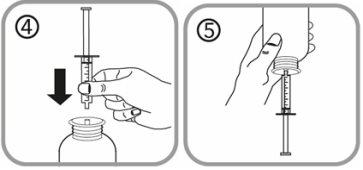
- Держите флакон вниз с одной рукой и используйте другую руку, чтобы наполнить шприц для перорального применения.
- Потяните за поршень вниз, чтобы наполнить шприц для перорального применения небольшым количеством раствора (рисунок 6).
- Нажмите на поршень вверх, чтобы удалить возможные пузырьки (рисунок 7).
- Потяните за поршень вниз до деления, соответствующего миллилитрам (мл), назначенным вашим врачом (рисунок 8). Возможно, поршень вернется в исходное положение при первой дозе. Поэтому убедитесь, что он остается в этом положении до тех пор, пока шприц для перорального применения не будет отсоединен от флакона.
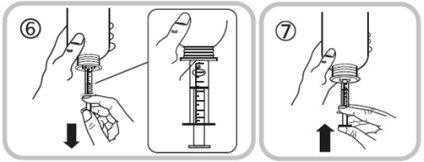
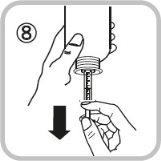
- Поверните флакон в правильное положение (рисунок 9).
- Удалите шприц для перорального применения из адаптера (рисунок 10).
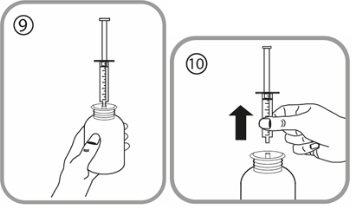
Существует два способа, которыми вы можете выбрать для приема препарата:
- Выпустите содержимое шприца для перорального применения в немного воды, нажимая на поршень до конца шприца для перорального применения (рисунок 11) - в этом случае вам необходимо выпить всю воду (добавьте воду, чтобы было легче пить) или
- Принимайте раствор直接 из шприца для перорального применения без воды (рисунок 12) - выпейте все содержимое шприца для перорального применения.
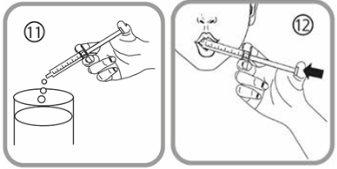
- Закройте флакон крышкой с резьбой (не нужно удалять адаптер).
- Для очистки шприца для перорального применения промойте его только холодной водой, перемещая поршень несколько раз вверх и вниз, чтобы собрать и выпустить воду, не разделяя два компонента шприца (рисунок 13).
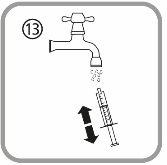
- Сохраните флакон, шприц для перорального применения и инструкцию в упаковке.
Если вы приняли слишком много Вимпата
Если вы приняли слишком много Вимпата, проконсультируйтесь с вашим врачом немедленно. Не пытайтесь управлять транспортным средством. Вы можете испытывать:
- Головокружение.
- чувство тошноты или рвоты.
- приступы, проблемы с сердечным ритмом, такие как медленный, быстрый или нерегулярный пульс, кома или снижение артериального давления с тахикардией и потоотделением.
Если вы забыли принять Вимпат
- Если вы забыли принять дозу в течение 6 часов после запланированной дозы, примите ее как можно скорее.
- Если вы забыли принять дозу после 6 часов после запланированной дозы, не принимайте пропущенную дозу. Вместо этого примите Вимпат в следующий раз, когда обычно принимаете его.
- Не принимайте двойную дозу, чтобы компенсировать пропущенные дозы.
Если вы прекратите лечение Вимпатом
- Не прекращайте принимать Вимпат без консультации с вашим врачом, поскольку эпилепсия может появиться снова или ухудшиться.
- Если ваш врач решит прекратить ваше лечение Вимпатом, он даст вам инструкции о том, как постепенно уменьшить дозу.
Если у вас есть другие вопросы о применении этого продукта, проконсультируйтесь с вашим врачом или фармацевтом.
4. Возможные побочные эффекты
Как и все лекарства, это лекарство может вызывать побочные эффекты, хотя не все люди испытывают их.
Побочные эффекты в нервной системе, такие как головокружение, могут быть более выраженными после единой дозы "загрузки".
Сообщите своему врачу или фармацевту, если у вас возникнут следующие эффекты:
Очень частые: могут возникать у более 1 из 10 пациентов
- Головная боль;
- Чувство головокружения или тошноты (наusea);
- Двойное зрение (диплопия).
Частые: могут возникать у до 1 из 10 пациентов
- Кратковременные сокращения мышц или группы мышц (миоклонические судороги);
- Трудности с координацией движений или ходьбы;
- Проблемы с поддержанием равновесия, тремор (тремор), онемение (парестезия) или мышечные спазмы, частые падения и образование синяков;
- Проблемы с памятью, трудности с мышлением или поиском слов, путаница;
- Быстрые и неконтролируемые движения глаз (нистагмус);
- Размытое зрение;
- Чувство головокружения (вертиго), чувство опьянения;
- Рвота (рвота), сухость во рту, запор, изжога, газы в желудке или кишечнике, диарея;
- Уменьшение чувствительности, трудности с артикуляцией слов, нарушение внимания;
- Шум в ушах, такой как жужжание, свист или писк;
- Раздражительность, проблемы со сном, депрессия;
- Сонливость, усталость или слабость (астения);
- Зуд, сыпь.
Редкие: могут возникать у до 1 из 100 пациентов
- Уменьшение частоты сердечных сокращений, перебои в работе сердца, нерегулярный пульс или другие изменения в электрической активности сердца (нарушение проводимости);
- Чрезмерное чувство благополучия, видение и/или слышание вещей, которые не существуют;
- Аллергическая реакция на прием лекарства, крапивница;
- Анализы крови могут показать аномалии функции печени, повреждение печени;
- Мысли о самоубийстве или попытки самоубийства: сообщите врачу немедленно;
- Чувство гнева или раздражения, аномальные мысли и/или потеря чувства реальности;
- Тяжелые аллергические реакции, которые вызывают отек лица, горла, рук, ног, лодыжек или нижних частей ног;
- Обморок;
- Аномальные непроизвольные движения (дискинезия).
Частота не известна: не может быть оценена на основе доступных данных
- Аномально быстрый сердечный ритм (жесткая аритмия желудочков);
- Боль в горле, повышенная температура и частые инфекции. Анализы крови могут показать значительное уменьшение определенного типа белых кровяных клеток (агранулоцитоз);
- Тяжелая кожная реакция, которая может включать повышенную температуру и другие симптомы, подобные гриппу, сыпь на лице, общая сыпь с воспалением лимфатических узлов (увеличенные лимфатические узлы). Анализы крови могут показать увеличение уровня печеночных ферментов и увеличение количества определенного типа белых кровяных клеток (эозинофилия);
- Общая сыпь с пузырями и шелушением кожи, особенно вокруг рта, носа, глаз и гениталий (синдром Стивенса-Джонсона) и более тяжелая форма, которая вызывает шелушение кожи на более чем 30% поверхности тела (токсический эпидермальный некролиз).
- Судороги.
Другие побочные эффекты у детей
Дополнительные побочные эффекты, наблюдаемые у детей, были лихорадкой (пирексией), насморком (насофарингитом), болью в горле (фарингитом), снижением аппетита, изменениями поведения, необычным поведением и отсутствием энергии (летаргией). Чувство сонливости (сонливость) является очень частым побочным эффектом у детей и может возникать у более 1 из 10 детей.
Сообщение о побочных эффектах
Если вы испытываете любой побочный эффект, проконсультируйтесь с врачом или фармацевтом, даже если это возможные побочные эффекты, которые не указаны в этом листке-вкладыше. Вы также можете сообщить об этом напрямую через национальную систему уведомления, указанную в Приложении V. Сообщая о побочных эффектах, вы можете способствовать предоставлению более полной информации о безопасности этого лекарства.
5. Хранение Вимпата
Храните это лекарство в недоступном для детей месте.
Не используйте это лекарство после даты истечения срока годности, указанной на упаковке и флаконе, после CAD/EXP. Дата истечения срока годности - последний день месяца, указанного.
Не храните в холодильнике.
Не требует специальных условий хранения.
После открытия флакона с сиропом не используйте его после 6 месяцев.
Лекарства не должны выбрасываться в канализацию или мусор. Спросите у фармацевта, как утилизировать упаковку и лекарства, которые вам больше не нужны. Таким образом, вы поможете защитить окружающую среду.
6. Содержимое упаковки и дополнительная информация
Состав Вимпата
- Активное вещество - лакозамида. 1 мл сиропа Вимпат содержит 10 мг лакозамиды.
- Другие компоненты: глицерол (Е422), кармелоза натрия, жидкий сорбитол (кристаллизирующий) (Е420), полietilengликоль 4000, хлорид натрия, лимонная кислота (безводная), ацесульфам калия (Е950), метилпара-гидроксибензоат натрия (Е219), фруктовый вкус (содержит пропиленгликоль, мальтол), маскирующий вкус (содержит пропиленгликоль, аспартам (Е951), ацесульфам калия (Е950), мальтол и дистиллированную воду).
Внешний вид продукта и содержимое упаковки
- Сироп Вимпат 10 мг/мл - прозрачная вязкая жидкость от бесцветной до светло-коричневой.
- Вимпат выпускается в флаконе по 200 мл.
Упаковка сиропа Вимпат включает мерный стакан из полипропилена на 30 мл (черные деления) и орального шприца из полietилена/полипропилена на 10 мл (черные деления) с адаптером из полietилена.
- Мерный стакан подходит для дозировки более 20 мл. Каждое деление (5 мл) мерного стакана соответствует 50 мг лакозамиды (например, 2 деления соответствуют 100 мг).
Оральный шприц на 10 мл подходит для дозировки от 1 мл до 20 мл. Наполненный оральный шприц на 10 мл соответствует 100 мг лакозамиды. Минимальный объем, который можно извлечь, составляет 1 мл, что соответствует 10 мг лакозамиды. После этого каждое деление (0,25 мл) соответствует 2,5 мг лакозамиды (например, 4 деления соответствуют 10 мг).
Владелец разрешения на маркетинг
UCB Pharma S.A., Allée de la Recherche 60, B-1070 Брюссель, Бельгия.
Производитель
Aesica Pharmaceuticals GmbH, Alfred-Nobel Strasse 10, D-40789 Монхайм-ам-Рейне, Германия
или
UCB Pharma SA, Chemin du Foriest, B-1420, Брен-л'Аллё, Бельгия.
Вы можете получить дополнительную информацию о этом лекарстве, обратившись к местному представителю владельца разрешения на маркетинг:
Бельгия UCB Pharma SA/NV Тел: + 32 / (0)2 559 92 00 | Литва UCB Pharma Oy Finland Тел: + 358 9 2514 4221 (Финляндия) |
| Люксембург UCB Pharma SA/NV Тел: + 32 / (0)2 559 92 00 (Бельгия) |
Чехия UCB s.r.o. Тел: + 420 221 773 411 | Венгрия UCB Magyarország Kft. Тел: + 36-(1) 391 0060 |
Дания UCB Nordic A/S Тел: + 45 / 32 46 24 00 | Мальта Pharmasud Ltd. Тел: + 356 / 21 37 64 36 |
Германия UCB Pharma GmbH Тел: + 49 /(0) 2173 48 4848 | Нидерланды UCB Pharma B.V. Тел: + 31 / (0)76-573 11 40 |
Эстония UCB Pharma Oy Finland Тел: + 358 9 2514 4221 (Финляндия) | Норвегия UCB Nordic A/S Тел: + 47 / 67 16 5880 |
Греция UCB Α.Ε. Тел: + 30 / 2109974000 | Австрия UCB Pharma GmbH Тел: + 43 (0) 1291 80 00 |
Испания UCB Pharma, S.A. Тел: + 34 / 91 570 34 44 | Польша UCB Pharma Sp. z o.o. / VEDIM Sp. z o.o. Тел: + 48 22 696 99 20 |
Франция UCB Pharma S.A. Тел: + 33 / (0)1 47 29 44 35 | Португалия UCB Pharma (Produtos Farmacêuticos), Lda Тел: + 351 21 302 5300 |
Хорватия Medis Adria, d.o.o. Тел: +385 (0) 1 230 34 46 | Румыния UCB Pharma Romania S.R.L. Тел: + 40 21 300 29 04 |
Ирландия UCB (Pharma) Ireland Ltd. Тел: + 353 / (0)1-46 37 395 | Словения Medis, d.o.o. Тел: + 386 1 589 69 00 |
Исландия Vistor hf. Тел: + 354 535 7000 | Словакия UCB s.r.o., organizačná zložka Тел: + 421 (0) 2 5920 2020 |
Италия UCB Pharma S.p.A. Тел: + 39 / 02 300 791 | Финляндия UCB Pharma Oy Finland Тел: + 358 9 2514 4221 |
Кипр Lifepharma (Z.A.M.) Ltd Тел: + 357 22 05 63 00 | Швеция UCB Nordic A/S Тел: + 46 / (0) 40 29 49 00 |
Латвия UCB Pharma Oy Finland Тел: + 358 9 2514 4221 (Финляндия) | Великобритания (Северная Ирландия) UCB (Pharma) Ireland Ltd Тел: + 353 / (0)1-46 37 395 |
Дата последнего пересмотра этого листка-вкладыша:{месяц/год}.
Другие источники информации
Подробная информация о этом лекарстве доступна на сайте Европейского агентства по лекарственным средствам: http://www.ema.europa.eu/.

Сколько стоит ВИМПАТ 10 мг/мл СИРОП в Испании в 2025 году?
Средняя цена на ВИМПАТ 10 мг/мл СИРОП в декабрь, 2025 года составляет около 23.49 евро. Финальная стоимость может зависеть от региона, конкретной аптеки и рецептурного статуса. Для точной информации лучше проверить онлайн или в ближайшей аптеке.
- Страна регистрации
- Средняя цена в аптеках23.49 EUR
- Активное вещество
- Требуется рецептДа
- Производитель
- Информация носит справочный характер и не является медицинской рекомендацией. Перед приемом любых препаратов проконсультируйтесь с врачом. Oladoctor не несет ответственности за медицинские решения, принятые на основе этого контента.
- Аналоги ВИМПАТ 10 мг/мл СИРОПФорма выпуска: ТАБЛЕТКА, 100 мгАктивное вещество: ЛакосамидПроизводитель: Intas Third Party Sales 2005 S.L.Требуется рецептФорма выпуска: ТАБЛЕТКА, 150 мгАктивное вещество: ЛакосамидПроизводитель: Intas Third Party Sales 2005 S.L.Требуется рецептФорма выпуска: ТАБЛЕТКА, 200 мгАктивное вещество: ЛакосамидПроизводитель: Intas Third Party Sales 2005 S.L.Требуется рецепт
Аналоги ВИМПАТ 10 мг/мл СИРОП в других странах
Лучшие аналоги с тем же действующим веществом и терапевтическим эффектом.
Аналог ВИМПАТ 10 мг/мл СИРОП в Polónia
Аналог ВИМПАТ 10 мг/мл СИРОП в Ukraine
Врачи онлайн по ВИМПАТ 10 мг/мл СИРОП
Консультация по дозировке, побочным эффектам, взаимодействиям, противопоказаниям и продлению рецепта на ВИМПАТ 10 мг/мл СИРОП – по решению врача и с учетом местных правил.








